
Toward a mobility operating system Establishing a lingua franca for urban transportation
19 minute read
25 July 2019
The new mobility ecosystem is rapidly expanding, with new technologies, infrastructure, providers, and modes of transport. How to integrate them all and keep everything on track? With a mobility operating system.
Introduction: Urban intermodal transportation
For some 200,000 years, humans were, chiefly, a rural species. Driven by the demands of hunting, gathering, and eventually pastoralism and agriculture, population densities remained low. Great cities served as important hubs for exchange, to be sure—Ur, Thebes, Babylon, Athens, Rome, Chang’an, Tenochtitlan, and others—but they were far from most people’s daily lives.1
Learn More
Read more from the Future of mobility collection
Explore the Smart cities collection
Subscribe to receive related content
Two and a half centuries ago, as the Industrial Revolution unfolded, that story began to change (see figure 1). A variety of economic, political, and technological forces converged, drawing more and more people into cities. As Sidewalk Labs CEO Dan Doctoroff notes, the steam engine, the electric grid, and the automobile “brought people and goods to cities across long distances [and] enabled them to become industrialized on a scale that was not possible before.”2 Our great migration from the countryside to ever-larger metropolises has been a defining arc in the human story. In 2010, for the first time, more people lived in urban than rural areas. Our rising urbanization shows few signs of abating.3
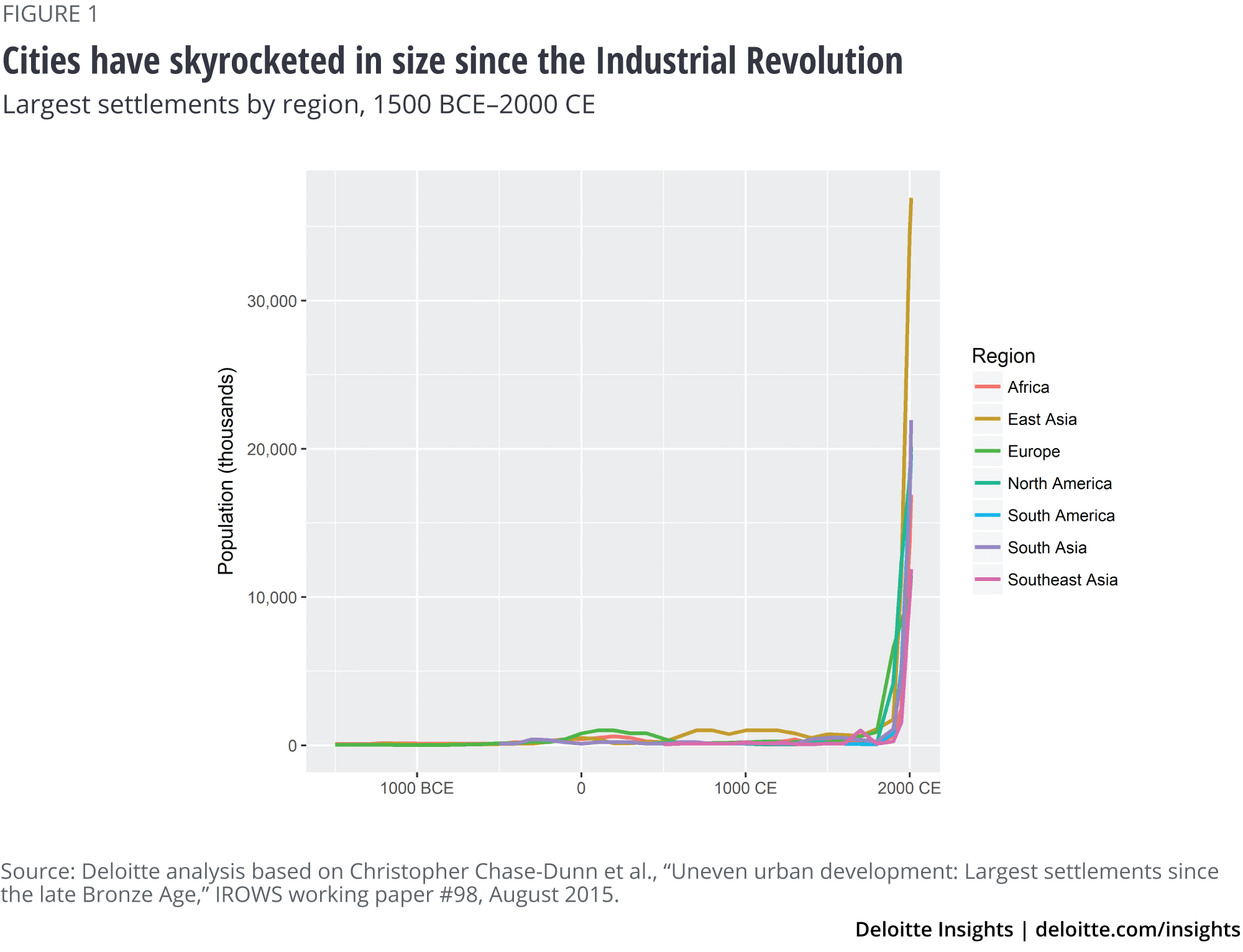
These great shifts have been accompanied by tremendous opportunities—and challenges. Cities have been engines of ingenuity, innovation, and economic growth and innovation. They are the centers of commerce, and they have incubated many of our greatest achievements in the arts and sciences. But they face an increasingly complex set of issues associated with feeding, housing, protecting, employing, and transporting a growing influx of citizens. Saddled by legacy infrastructure and limited budgets, many urban areas are struggling to keep pace with increased populations and growing volumes of freight, often leading to increased congestion, lower quality of life, lost economic potential, and negative health outcomes. The contours of many cities today look far different than they did when public transit systems were first established, often decades earlier. Young families populate many neighborhoods that once housed factories. Farm fields that grew corn now sprout subdivisions. Yet in many instances, the transportation networks serving these areas remain fundamentally unchanged, struggling with unforeseen traffic and ridership.4
More recently, and partially in response, a dizzying array of mobility-related innovations have emerged that could help address many of those challenges. Many urbanites are flocking to these expanded transportation options—carsharing, ride-hailing, bikesharing, e-scooters, and others—in many cases substituting for existing outmoded, inconvenient, and inaccessible transit systems. With the emergence of shared autonomous mobility, connected infrastructure, and smart cities technologies, the prospects for an urban intermodal transportation ecosystem that is faster, cheaper, cleaner, and safer appear closer than ever.5 Realizing this vision, however, is likely to require more than a series of one-off, point solutions. Indeed, on their own, new mobility services may only exacerbate the current transportation system’s friction and inefficiencies by adding complexity and additional transaction costs while siphoning off demand from existing modes with slow-to-adjust prices (such as public buses).
But there could be a way to achieve a Pareto-improving, more efficient outcome in the near term by overlaying onto today’s transportation system a citywide digital platform to facilitate transparency, interoperability, coordination, and control: a mobility operating system.6 Without it, planners will likely struggle to see gains from new forms of mobility—and from the investments of players across the ecosystem—for a decade or more.
This article explores some of the key capabilities and technological components of an integrated mobility platform and how city leaders could deploy them now to help alleviate some of their pressing mobility challenges and accelerate systemwide gains. It also examines some of the likely essential prerequisites for implementing such a system, from data and technology to the always-thorny issues of financing, civic engagement, private investment, and political leadership and courage.
Cities’ mobility challenge
While conditions vary dramatically across the globe, many of the world’s largest cities are straining to meet their citizens’ mobility needs. Fueled by population growth, urbanization, often-misaligned transportation systems, and a shortfall of investment in public infrastructure, congestion and other transportation-related challenges are having a deleterious impact on urban life.
Urban populations have grown steadily since 1950 (see figure 2).7 Today, roughly 4 billion people live in urban areas, a number the United Nations expects to reach more than 6 billion by 2050—two out of every three people on earth.8 While most cities remain relatively small, more than 500 of them are home to at least 1 million people. By 2030, there could be 41 “megacities” with populations of more than 10 million; there are already 11 such cities in China and India alone.9 Unsurprisingly, analysts expect the demand for mobility within cities to increase accordingly, with global urban passenger-miles almost doubling across all modes by 2050 (see figure 3).10 In most cities, public infrastructure and transit systems simply cannot keep pace with the growth. There is already an estimated US$1 trillion shortfall in global infrastructure spending.11 In the absence of major policy and technological changes, by 2050, roughly 15 million additional miles of paved roads and 30,000 square miles of parking spaces could be needed to meet global demand.12
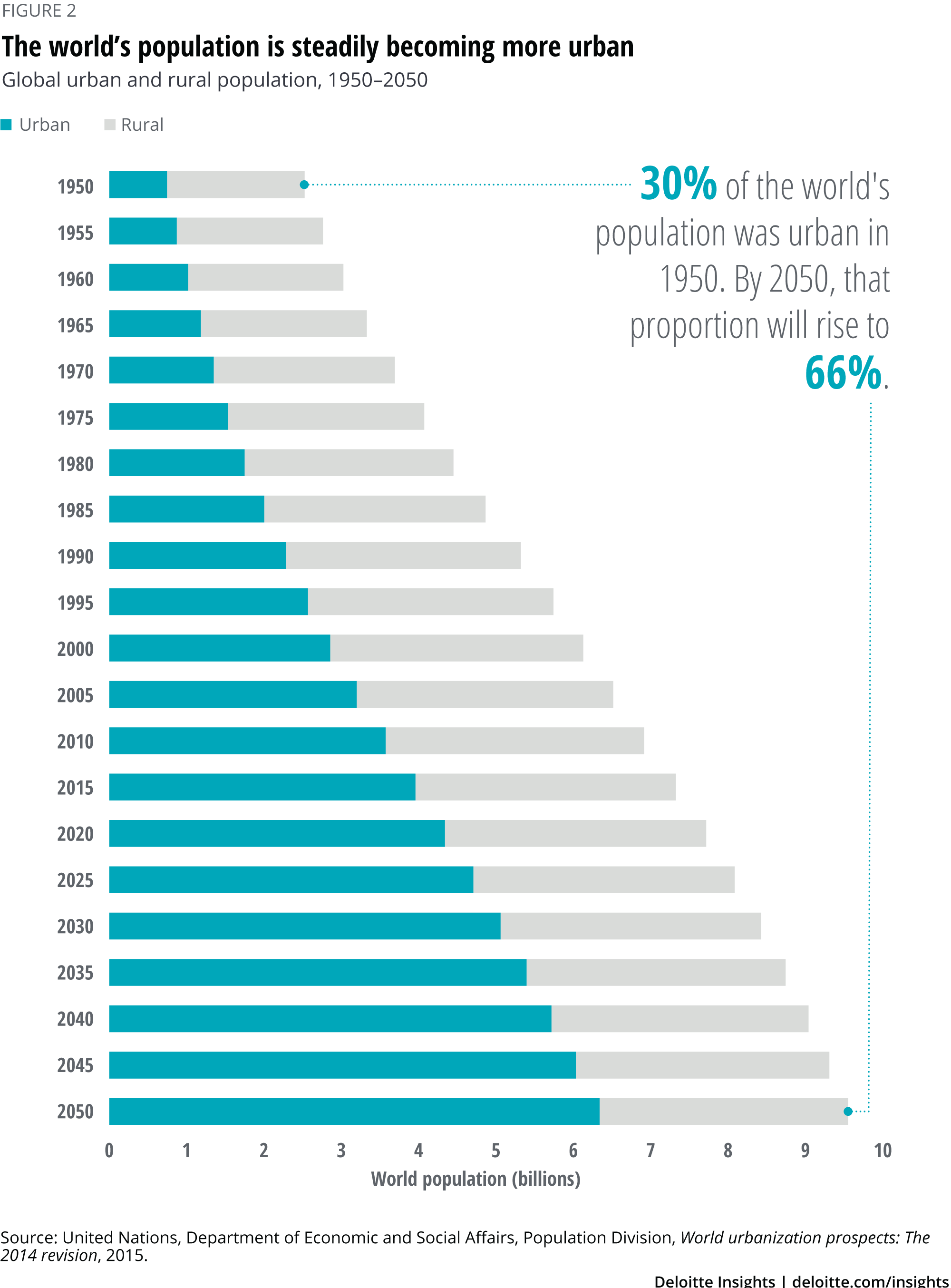
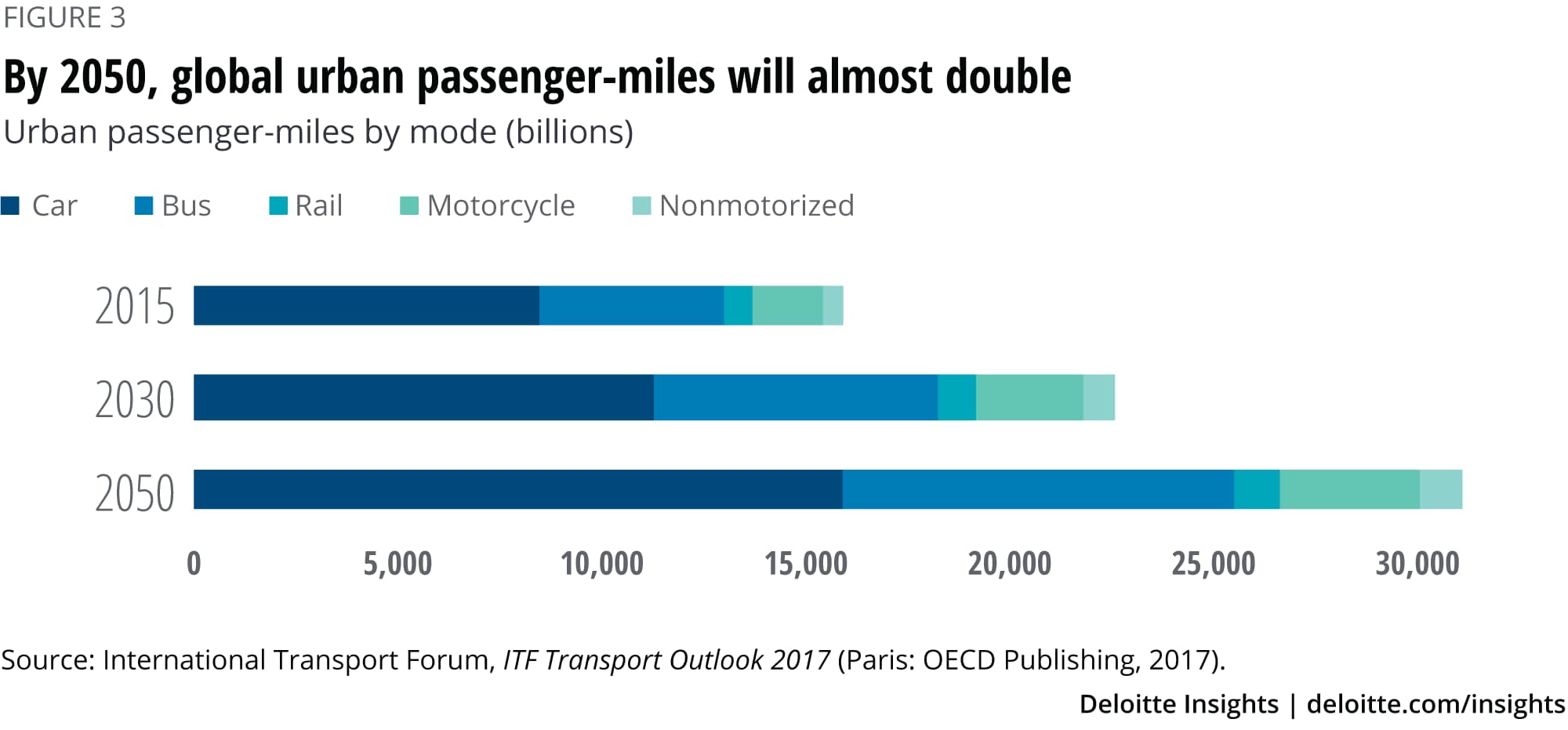
Already, many cities are experiencing the downsides associated with overloaded and inefficient roads and transit systems. In the most congested cities, drivers spend between 100 and 200-plus hours per year—two to five entire workweeks—stuck in traffic.13 The cumulative impact on US GDP of deteriorating infrastructure could exceed US$500 billion annually by 2040.14
Congestion may be the most visible symptom of cities’ mobility-related challenges, but it is by no means the only one. Based on data from roughly 3,000 cities, nearly 80 percent of people living in urban areas are exposed to air pollution—much of it attributable to vehicle emissions15—that exceeds World Health Organization recommendations, increasing the risk of a variety of respiratory diseases, heart disease, stroke, and lung cancer.16 In OECD countries alone, more than 7 million years of life were lost due to ambient air pollution in 2010, about 50 percent of which comes from road transit.17 In major US urban areas, the annual health costs of congestion exceed US$30 billion.18 The act of commuting itself is associated with poorer health outcomes.19 And research suggests that access to transportation is one of the most important factors for escaping poverty in cities.20
Harnessing the future of mobility
In most cities, a reincarnation of New York “master builder” Robert Moses’s vision will not solve this problem; simply building more roads is as likely to exacerbate the issues as alleviate them.21 With constrained budgets and finite space, cities must figure out how to enable greater throughput—moving more people and goods through either the existing transportation system or by adding additional capacity (without creating more traffic)—across the entire transportation system. This will likely require significant modernization of the entire network and managing mobility holistically as a “system of systems.” Today’s system is far from optimized; there are massive costs associated with the imbalances between supply and demand. Through a combination of new forms of mobility, more flexible and adaptive pricing, and digitization of the entire system, an extraordinary opportunity exists to reach a new, more efficient equilibrium point that could enable traveling faster, cheaper, and more conveniently than today.
As many private-sector actors have sought to capitalize on the inefficiencies and gaps in existing transportation networks, new mobility-related services and solutions have proliferated. Responding to market need, these new offerings cover the gamut of urban concerns: traffic efficiency, public safety, commerce, sustainability, accessibility, equity, and health and welfare. As Ramayya Krishnan, dean of the Heinz College of Information Systems and Public Policy at Carnegie Mellon University, notes, “Technology has transformed and is continuing to enable rapid innovation in mobility services. Government has to innovate on policy but has not done so. In the meantime, people are adopting services based on their individual cost-convenience trade-offs.”22 The last several years have seen significant advances in:
- Trip planning and dynamic routing, including multimodal trip planning, wayfinding, freight routing, real-time traffic management, and data analytics. A number of cities, including Helsinki, Paris, Los Angeles, and Singapore, are experimenting with mobility-as-a-service (MaaS), which relies “on a digital platform that integrates end-to-end trip planning, booking, electronic ticketing, and payment services across all modes of transportation, public or private.”23 All of these are aimed at reducing vehicle traffic and optimizing an individual’s journey, not the city’s transportation system, and so do little to improve systemwide inefficiencies.
- Vehicle-to-vehicle and vehicle-to-infrastructure connectivity and smart infrastructure that can help smooth traffic flow (through smart traffic lights), reduce the number of accidents (for example, through vehicle connectivity and smart crosswalks), lower electrical consumption (via smart street lights), monitor air quality, and service a growing fleet of electric vehicles (through electric charging stations).
- New modes of mobility—notably, carsharing, bikesharing, e-scooters, ride-hailing, and microtransit. The growth of electric vehicles and the emergence of autonomous vehicles could dramatically reshape urban mobility options.
- Real estate utilization, including smart curbs, smart metering, and smart parking. There could be more than 1 million on-street smart parking spaces globally by 2026.24
- Payments and ticketing, which encompasses the ability to pay for an entire multimodal trip with a single charge (unified payment), and the adoption of surge- and usage-based pricing.
While promising, deploying uncoordinated and isolated point solutions is likely to leave many of the systemwide benefits unrealized—“imagine a passenger-less autonomous vehicle being sent to pick up dry cleaning during rush hour,” notes mobility expert and MIT executive director John Moavenzadeh.25 Indeed, it is possible that adding self-driving cars and other solutions could exacerbate, rather than alleviate, a city’s mobility challenges. Transportation network companies’ services have already added 5.7 billion miles of driving in the nine largest US cities.26 New modes of mobility interact with existing public transit in complex ways and, in some cases, could cannibalize usage or fail to serve populations most in need.27 In New York, 50 percent of ride-hail trips would have otherwise been made using transit, according to the city’s surveys.28
Greater than the sum of its parts: The mobility operating system
To truly harness emerging technologies to solve the most vexing problems, cities would need a comprehensive, integrated system that transcends existing infrastructure, drives standardization and interoperability, enables value creation by key parties, and cultivates technological advancements. In other words, a city would need a mobility operating system (mOS): an integrated platform that brings together physical infrastructure (roads, rails), modes of transport (cars, public transit, ridesharing, bike sharing, etc.), and transportation service providers (aggregators, public transport system) and creates greater throughput and optimization systemwide through market clearing mechanisms (see figure 4).
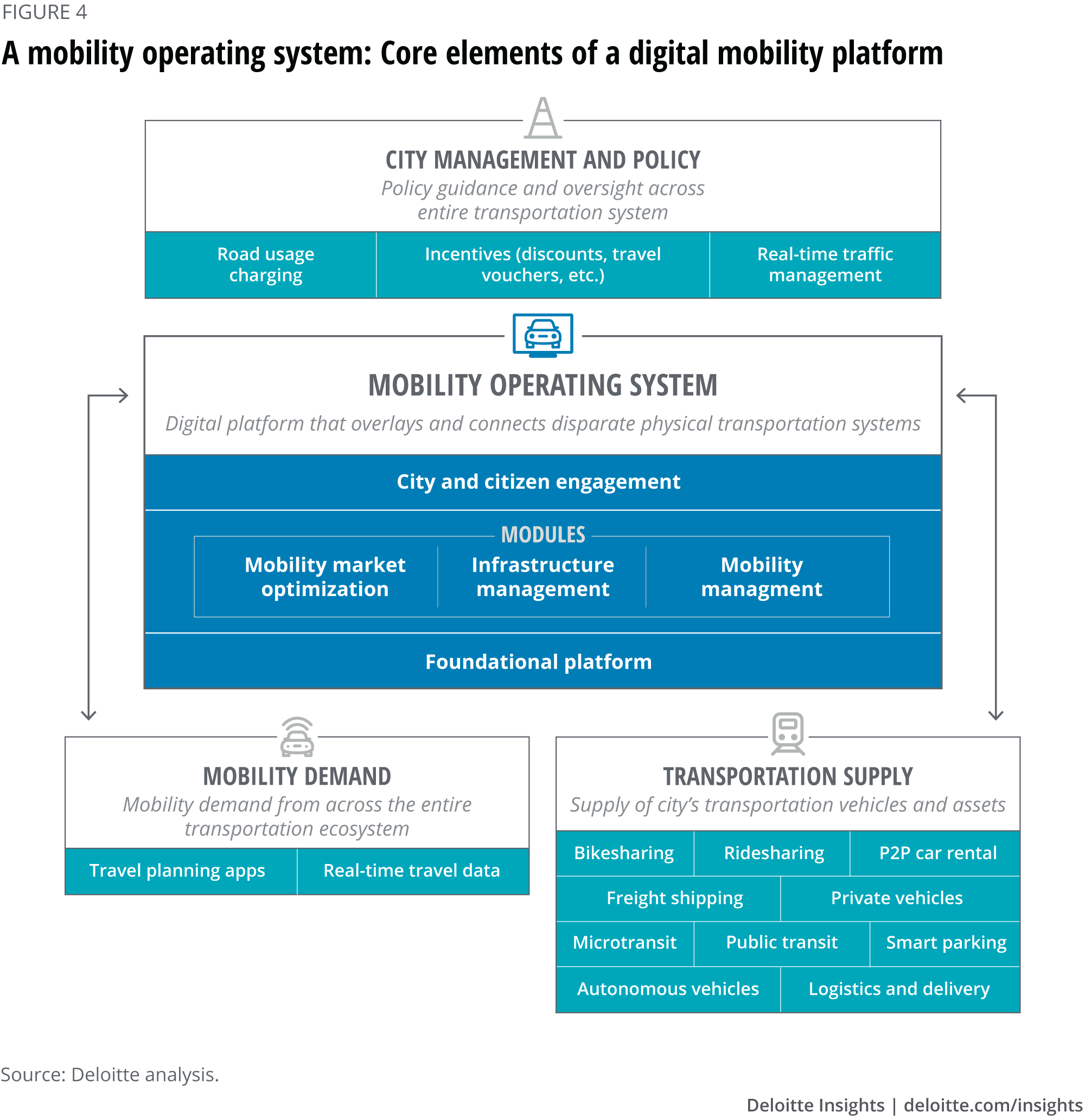
The platform combines advances in Internet of Things technology, big data, and cognitive analytics to more efficiently align supply and demand, while catering to individual preferences and optimizing transport resources to improve urban life. At its core, it is enabled by a dynamic nerve center that:
- Provides a central data exchange for the various types of mobility-related data generated by sensors, transponders, and via electronic transactions throughout the city;
- Creates visibility into network capacity across modes;
- Shows real-time consumption of different forms of mobility by mode and location;
- Enables historical analyses of supply and demand to adapt the transportation system to be more fit for future purposes;
- Creates market-driven incentives to shift consumption choices; practically, that could mean offering discounts for people to opt for less utilized and perhaps slower routes, or to shift their travel to off-peak times;
- Offers a transaction platform that creates a new source of revenue for the city and expands the market for transit service companies and passengers by offering a wider array of choices to travel from point A to point B seamlessly; and
- Smooths out peaks and valleys in demand, creating greater throughput and system optimization.
The capabilities of an integrated mobility platform can benefit a wide range of stakeholders.
City transportation managers can gain a real-time perspective of the entire mobility network, as the system would ingest data from multiple sources, including vehicle- and infrastructure-based sensors (such as GPS-based city bus tracking and smart traffic lights that monitor vehicle flow) and citizens’ digital footprints (such as smartphone-enabled geolocation and electronic fare charges by mode). Drawing on that information, the system can then enable the city to equilibrate supply and demand and facilitate traffic throughput by adjusting incentives, most directly by calibrating prices across modes and locations but also through the use of behavioral nudges such as framing and social proofs (by, for example, highlighting how many of a person’s neighbors use public transit to travel a similar route to work).29
The system can utilize such data to conduct predictive analytics, modeling out system capacity and utilization under a variety of conditions (peak traffic or a major sporting event, for example). They can also be used for longer-range scenario evaluation, allowing city leaders to understand the trade-offs inherent in infrastructure, policy, and operational choices and how they might affect the city and its citizens. That could allow for more informed decision-making about, say, whether it would be better to invest in a new light rail system or dynamic shuttles, and where to place those assets. There are also advanced planning tools that could dynamically simulate the impact of alternative configurations of mobility.
An agency’s overarching role is planning and operational performance oversight, and relative to an integrated mobility platform would be mostly oversight of a decentralized system, similar to how buyers and sellers come together via a stock exchange for which the government sets rules and policies around information symmetry, fairness in the transaction, transparency, and fees. The system could also offer multiple avenues to create a valuable municipal revenue source that could offset declining tax revenues, at a time when city governments need funding for critical infrastructure and other projects.
A city’s mobility platform can help equilibrate supply and demand and facilitate traffic throughput by adjusting incentives, most directly by calibrating prices across modes and locations but also through the use of behavioral nudges such as framing and social proofs.
Private-sector service providers would be able to reach new markets and consumers, while optimizing the size of vehicle fleets deployed at different times of the day and reducing “empty miles” (miles traveled with no passengers) and costs. A platform-administered unified payment system could facilitate a single payment across modes, simplifying fare collection across mobility providers—until now, a stumbling block in many MaaS applications.30 The system and its requisite data clearinghouse can also enable ticketless travel and a variety of payment options, including pay-as-you-go and monthly subscriptions.
That said, an important plank in many private-sector mobility providers’ business model is the ability to capitalize on inefficiencies in the existing transportation network. Ride-hailing companies, for example, promise to connect riders with drivers more conveniently and quickly and at a lower cost than traditional taxis, while on-demand shared or shuttle buses add more flexibility relative to fixed-route buses. An integrated platform that optimizes across modes could challenge that approach and therefore limit companies’ desire to opt in. There will likely need to be incentives to strongly encourage adoption, especially early on when the tangible benefits have yet to materialize.
Finally, end users can enjoy a single interface to plan and pay for trips across all available modes of transport. The integrated platform could support MaaS, enabling each traveler to tailor her journey based on her priority, whether price, speed, modality, or some other feature.31 And users would benefit from reduced congestion, faster trips, and improved access to mobility.
The potential applications and use cases are extensive. Figure 5 suggests just one possibility, with mOS-based enhancements creating value for users at many points.
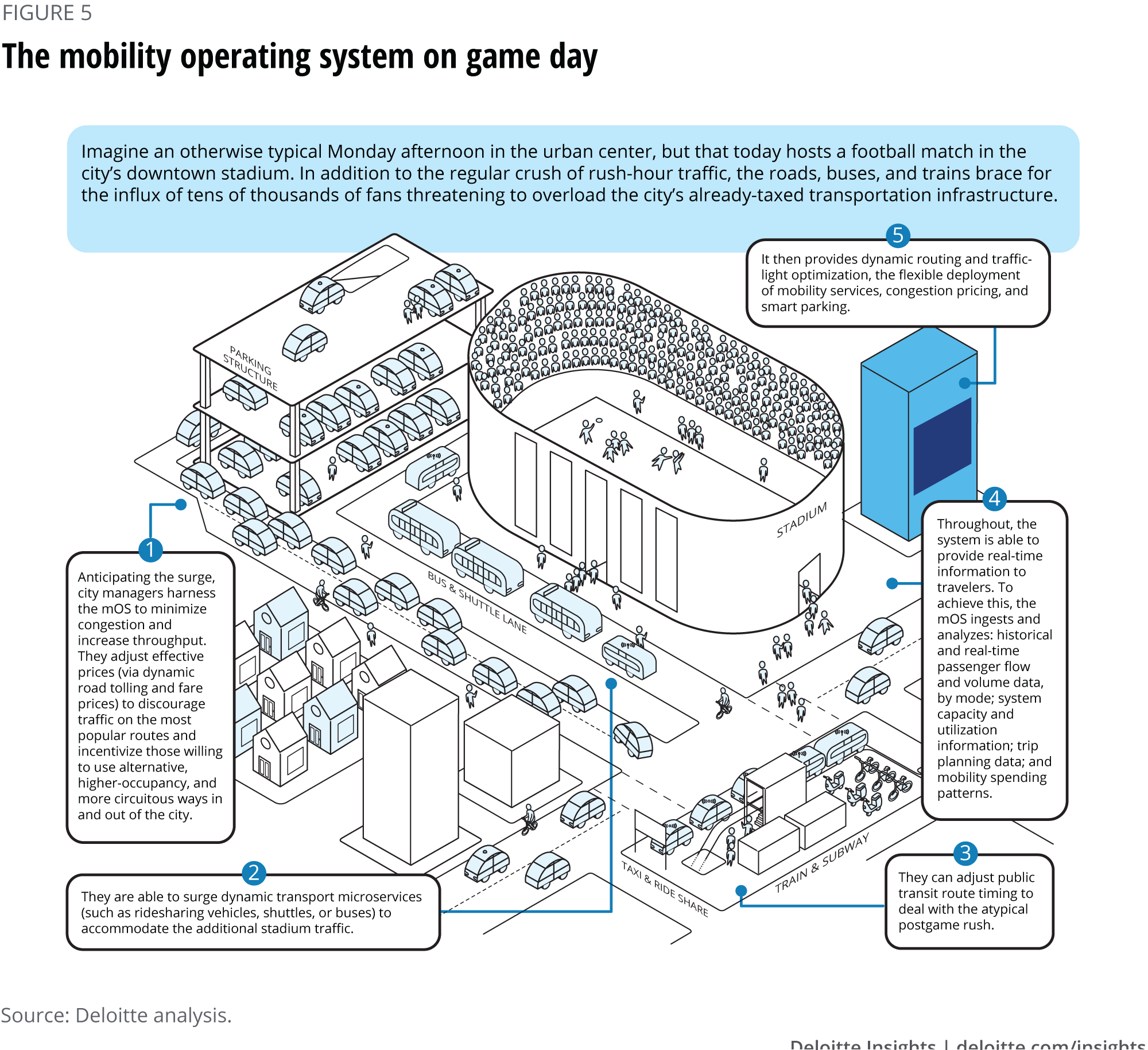
Another scenario: Meteorologists forecast a record-setting heat wave, to be accompanied by reduced air quality and dangerous conditions for vulnerable young and old populations. Knowing this, city managers are able to leverage connected infrastructure and the mobility platform to prepare for and mitigate the risks. To understand where “demand” for help might emerge, the system analyzes historical weather-related emergency calls by location throughout the city, along with weather and air quality data from sensors, geotagged demographic data, and a mapping of where vulnerable populations are located (schools and retirement homes, for instance). The mOS then marries that with information on the “supply” of emergency services, including historical 911 responder routes, police and fire department capacity and locations, and emergency call-box data.32 Using predictive analytics, the mobility platform can help determine where to predeploy emergency units to minimize response times. And when a call does come in, the system can dynamically direct first responders to the fastest possible route, adjusting traffic signals along the way to further speed their passage.
As the system matures, cities and the private sector could face a broad array of implications. Cities themselves could become mobility platforms upon which entrepreneurs and innovators can build new services and applications. Large players might lose their current data monopoly, introducing parity between new entrants and incumbents from tech firms to transit authorities. Local players may come to compete with mobility giants, leveraging partnerships with city officials and universities, as well as local insights and relationships. Improved and more affordable mobility solutions could lead to significantly reduced costs for consumers, allowing more savings and stimulating new spending. The platform could enable new revenue streams for city governments that align with future transportation trends, such as usage-based road pricing or congestion fees.
Accounting for the movement of goods within and beyond the city
Even as residents move about the city, a parallel form of mobility helps ensure that people have the food, clothing, and other goods they need and want. The World Bank estimates that, in a typical developed city, there are roughly 300 to 400 truck trips per 1,000 people every day, and that freight constitutes 10 to 15 percent of the vehicle miles traveled on city streets.33 And just as with passenger mobility, the movement of goods is in the midst of important innovations, especially for the “last mile” of delivery that is so critical in urban areas.34 The prospect of automated mobile lockers and drones could ease delivery bottlenecks and add flexibility to when goods are dropped off and picked up, and the prospect of drones or autonomous mobile lockers could further ease delivery bottlenecks.
The movement of goods is an important piece of a city’s mobility landscape, and any mobility platform must reckon with it. Efforts to minimize congestion or emissions are likely to be stymied if a city’s digital system lacks the necessary data and analytics to account for where delivery vehicles are headed and how they use infrastructure such as curbs. That likely means, at a minimum, gaining visibility into when and where freight is moving about the city, by which modes, and where. Stakeholders would also need to address sticky issues about how to balance the needs of passenger and goods mobility. For instance, minimizing rush-hour congestion could mean incenting freight to move during off-peak overnight hours, but that could conflict with when businesses need goods delivered or eat into carriers’ bottom lines if trucks are forced to delay deliveries until traffic subsides.
Toward a lingua franca for mobility
Mobility figures prominently in everything needed to make a city advanced, attractive, intelligent, responsive, and sustainable. Addressing cities’ most pressing challenges and making the most of the exciting advances in mobility likely requires fresh thinking about how urban transportation can work. It starts with moving beyond single-modality management and instead optimizing mobility as a “system of systems.” Few city governments are structured in a manner conducive to optimizing the full potential of a 21st-century mobility network. It would require a willingness to shed long-standing orthodoxies that all public transit is inherently more beneficial than private-sector options, especially since much of the funding for mobility innovation is coming from private capital. It would mean enabling more efficient use of current assets, upgrading much of the existing public transit infrastructure, and a willingness to shut down outdated legacy assets. Compounding these challenges, few cities’ financial conditions equip them to bear the cost of the investment required to meet tomorrow’s rush-hour needs. As cities consider a new wave of global infrastructure investment, it is nonetheless likely worth allocating some portion to building a mobility platform that can deliver value to their citizens quickly.
There are technical hurdles to implementing an integrated mobility platform, to be sure: “sensorizing” vehicles and infrastructure with IoT technology, establishing the tech architecture, operating and maintaining a sophisticated citywide system, and so on. But the greatest barriers are likely to be political, social, and economic. Cities’ current capabilities and future needs will vary widely around the world, and there is no one-size-fits-all approach. Some would begin as near-greenfield spaces, such as China’s emerging and planned cities, with opportunities to tailor modern systems for the future. Many others would be constrained by existing infrastructure—some of it a century or more old—and modes of transit, requiring a retrofit to make the best of what is already there.
The greatest barriers to an integrated mobility platform are likely to be political, social, and economic rather than technical.
In general, to successfully implement a digital mobility platform, municipalities should move beyond traditional transportation policy and funding frameworks. Some important challenges to consider:
- What outcome should be optimized? Participants’ goals will almost certainly vary, and agreeing on the key goals for the platform is likely to require deft negotiation. Private-sector players will presumably seek to maximize market access and profitability, while different areas of government might prioritize different outcomes that could be in conflict: reducing congestion, improving access for underserved communities, bettering air quality, making a city even more “people-centric” and pedestrian-friendly. Cities also support and manage public transit, which could conflict with private-sector interests.
Articulating a set of design principles, such as those reflected in the World Economic Forum’s work on a Seamless Integrated Mobility System,35 can help clarify the trade-offs and evaluate a platform’s performance.36 Determining how much weight to assign to each outcome, and how to incentivize different participants so that all parties perceive value, are likely to be critical in making a system successful. Those principles may include:- Societal outcomes, such as reducing congestion, decreasing travel times, expanding economic opportunity and access, and improving air quality;
- Consumer outcomes, including search costs for finding the optimal mode or modes, timing, and route for a given trip, and the direct cost paid by the traveler;
- Mobility provider outcomes, which include both opportunity for innovation and competition, the ability to enter and exit the market, and a fee structure that enables long-run viability and the ability to earn fair returns for their investments; and
- Public-sector outcomes, such as improved planning processes, the ability to derive data-driven insights about a city’s mobility network, and the generation of incremental revenue from (for example) data licensing, dynamic tolling, and per-trip fees.
- Does political leadership exist? City leadership with the willingness and ability to incentivize participation and restrict access to the urban transportation market is likely to be key. Having most or all of the major mobility service providers “on platform” is likely a necessary condition for cities and citizens to realize maximum value. Forging public-private partnerships could be one way forward.
- What levers are available to manage supply and demand by altering incentives for mobility providers and citizens? Most directly, that could manifest as real-time price adjustments (for example, congestion pricing on particular routes at rush hour). Less overt means of influence can also be effective—by, for example, leveraging behavioral science to shape choices and offering inducements (discounts) to travel via other modes and routes.37 Wherever possible, such adjustments should be market-driven rather than government-directed.
- How will data be collected, shared, and analyzed? What legal, security, and privacy concerns must be addressed, and how? An integrated mobility platform is predicated on an open exchange of data between public- and private-sector parties. The terms of that exchange, however, are likely to require careful deliberation to meet the needs of all participants. That would mean establishing protocols for what data is collected, how it is anonymized, where it can be stored, and to what ends it can be used. Implementing a system also means satisfying a potentially skeptical citizenry that highly personal data about how, where, and when people travel is being used responsibly. Without public trust, the digital platform would likely not be viable.
- How should an urban planning process be revised to sustainably optimize greater throughput? More infrastructure is simply not enough—urban challenges increasingly require more efficient use of existing assets, land, and the flexible deployment of new services that meet specific needs at times of peak demand. Intermodal optimization can multiply the potential benefits associated with shared autonomous fleets.
- What governance mechanisms are needed? “Technology is not the constraint,” observes Carnegie Mellon’s Ramayya Krishnan. Rather, it is the creation of a thoughtful and data-driven “operating model” for cities that is more responsive to mobility-related externalities and that is more enduring than a single leader.38 That likely means putting into place, where possible, new policymaking structures that can provide a more holistic view of the city’s mobility needs and can react with agility.
Many cities’ transportation networks are fragmented by political authority, policy jurisdiction, and public funding and thus have little incentive to cooperate in order to efficiently meet supply and demand. Effective mobility networks often cut across multiple jurisdictions and could encompass several municipalities, along with regional and federal authorities; the San Diego Association of Governments (SANDAG), for example, serves as a decision-making forum and plans and operates transportation in the greater San Diego area, with representatives from 19 local governments and advisors from numerous additional local, state, federal, and tribal organizations.39 Creating connectivity and interoperability across geographies and establishing regional networks can help avoid a patchwork of potentially conflicting systems. Achieving unity of purpose and a harmonized set of rules and decision-making procedures is likely to be just as essential. In many cases, that could require a bottom-up approach that starts with the “anchor jurisdiction for the broader metro area leading in building out what a mobility platform could look like, then encouraging neighboring communities to join,” notes MIT’s John Moavenzadeh,40 or the creation of a “chief mobility officer.”41 - Who pays? Financing is likely to pose a persistent and daunting challenge. Municipal bonds may be an option for some, but players should also think expansively about alternative funding mechanisms, including public-private partnerships, dynamic usage-based pricing, and per-transaction fees. Banks, investment funds, and other private enterprises may be willing to help fund a mobility platform in exchange for a portion of the returns it generates. Figuring out ways to incent or secure private investment could be key to implementing a system that delivers societal benefits akin to the advances that originally made cities into such vibrant centers.
While it is important to begin with the end in mind, establishing a fully realized mobility operating system is a significant endeavor likely to play out over the course of many years. Even so, there are tangible benefits that can be realized from more incremental steps—and that lay the foundation for additional capabilities as the system matures. For example, a city might begin by better understanding, utilizing, and managing its existing infrastructure and curb-space, perhaps in a particular neighborhood (figure 6). Leaders could build on that effort to eventually manage multiple modes of transportation across the city, improving congestion and accessibility, on the way to building a truly all-encompassing system that can create systemwide optimization.
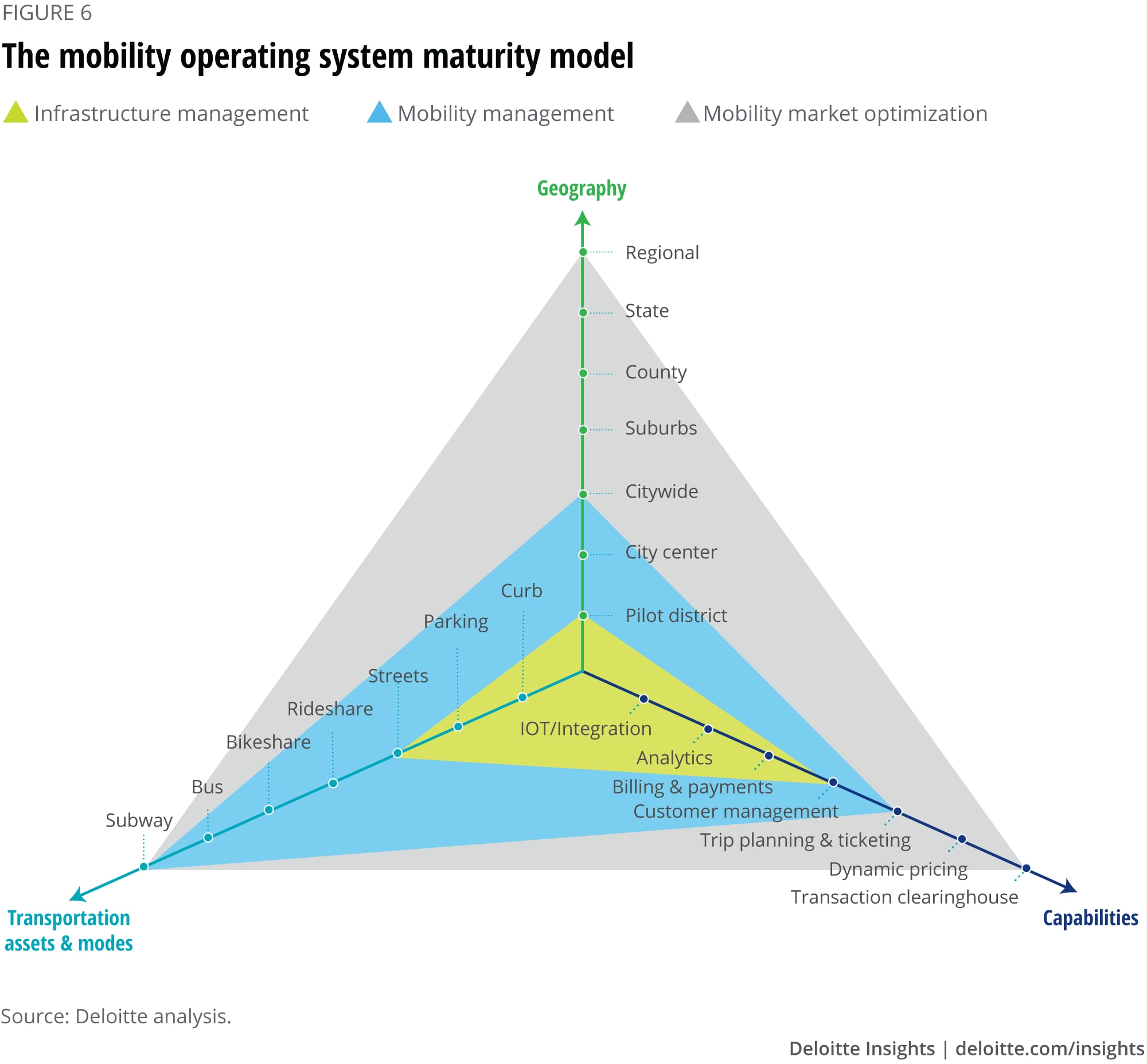
“Technology is not the constraint,” observes Carnegie Mellon’s Ramayya Krishnan. Rather, it is the creation of a thoughtful and data-driven “operating model” for cities that is more responsive to mobility-related externalities and that is more enduring than a single leader.
Conclusion: A Rosetta Stone for mobility
Two centuries ago, a soldier in Napoleon’s army discovered an artifact from one of the ancient world’s great cities, Memphis. The 2,000-year-old stone was inscribed with the words of a royal decree in two forms of Egyptian hieroglyphs and—crucially—ancient Greek. That object, dubbed the Rosetta Stone, became the key to deciphering Egyptian hieroglyphics and opening up an entire new realm of knowledge to the modern world.
A similar bridge—helping different types of parties communicate and work together—could greatly help to bring together the diversity of mobility interests in today’s complex urban areas. Twenty-first-century cities face tremendous challenges. As their populations swell, their ability to meet citizens’ transportation needs could be severely tested. Even if budgets were unconstrained, simply adding more roads would not be the answer. New mobility services offer great promise, but lack of coordination could make the problem worse, not better.
To make the most of the future of mobility, cities should harness the remarkable technological innovations of recent years to create a common platform that enables visibility, interoperability, and optimization across the transportation network’s many nodes and modalities. Putting new connected services in context and conversation—helping them work together for the benefit of users, third-party providers, and the city itself—will be key to realizing the benefits of the emerging mobility ecosystem.
Read more from the Future of Mobility collection
-
Tempering the utopian vision of the mobility revolution Article5 years ago
-
Technological barriers to the elevated future of mobility Article5 years ago
-
Payments and the future of mobility Article5 years ago
-
Picturing how advanced technologies are reshaping mobility Article5 years ago
-
How digital technologies can elevate car buying Article5 years ago
-
Monetizing data in the age of connected vehicles Article5 years ago













